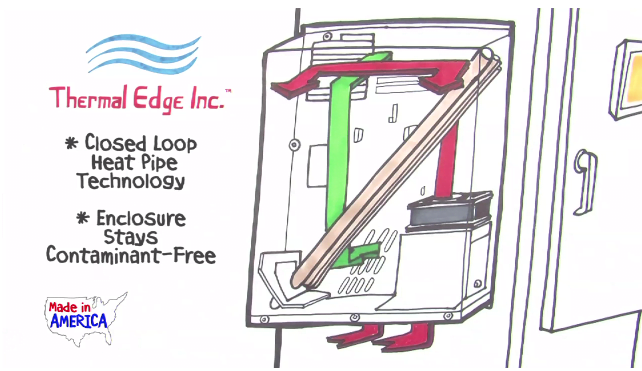The Right Way to Use an Air to Air Heat Exchanger

Air to air heat exchangers are an ideal solution for cooling electrical enclosures—when used correctly. What is the right way to use an air to air heat exchanger? Here are some tips.
Replace filtered fans that don’t cool enough
When components are failing inside electrical enclosures that rely on filtered fans for cooling, it’s time to consider a more powerful cooling solution.
As electrical components have decreased in size and increased in number and power, equipment inside electrical enclosures has become more tightly packed. These components are more likely to be exposed to waste heat caused by operating inefficiencies. The cooling capacity of a filtered fan may not be adequate for removing this heat, along with any additional heat from insolation, and/or nearby sources, such as ovens and boilers.
Air to air heat exchangers remove heat using a process similar to mechanical air conditioning, but without the compressor. Instead, they use a “heat pipe,” a sealed copper tube which contains liquid refrigerant under a partial vacuum. The lower section of the tube is in contact with heated air from the electrical enclosure. When the heat hits the refrigerant inside the tube, it vaporizes and then flashes to the top of the pipe, which is in contact with air from outside the enclosure.
Because the outside air temperature is lower than the enclosure temperature, the refrigerant vapor gives up heat to the air and returns to the liquid phase. The liquid falls to the bottom of the pipe, repeating the cycle endlessly, so long as there is a negative temperature differential between the outside air and the enclosure.
Protect electrical equipment from contaminants
No matter how well a filtered fan may cool an enclosure, or how well the filter blocks out contaminants, it will not be able to prevent every bit of dirt, dust, moisture, and chemical fumes from getting inside. Electronic equipment such as variable frequency drives (VFDs) and PLCs do not operate well in the presence of these contaminants.
Unlike a filtered fan system, an air to air heat exchanger operates as a “closed loop” system with no exposure to outside air. A baffle at the midpoint of the heat pipe coil, provides an airtight seal between the two air systems. In this way the air inside the enclosure is separated from–and is not contaminated with–ambient air, dirt, chemicals, dust, moisture or foreign matter. As a result, sensitive enclosure components are protected and are kept at the required operating temperature.
Specify the correct size
Because the heat pipe relies on a temperature differential, the ambient air temperature must be cooler than the enclosure operating temperature for it to work. This means an air to air heat exchanger can only be used in situations where the ambient temperature is lower than the desired enclosure temperature. The greater the temperature difference, the greater the quantity of heat that can be removed by the heat exchanger.
When sized properly, a heat exchanger will provide cooling to a temperature slightly higher than the ambient temperature. The delicate electronics, for example in programmable logic controllers (PLCs) may have maximum operating temperatures not far above room temperature. The operating temperature should be 10 to 20 degrees higher than the maximum ambient temperature.
A large heat exchanger removes 40 watts per degree Fahrenheit. So, assuming a temperature difference of 20 °F, the total quantity of heat that it can remove is 800 watts or 2,730 BTU/hr. (Use this online Enclosure Temperature Management Calculator for help in calculating the correct size of an air to air heat exchanger for your application.)
Choose the right options
Air to air heat exchangers come in a range of NEMA types to suit different applications. Typically, heat exchangers are used for NEMA Types 12, 4, and 4X, because they require a closed-loop cooling system sealed against outside air.
Once the correct cooling capacity and NEMA type have been determined, several other options are available to accommodate individual set-ups. For example, a corrosion protection package may be specified to provide coatings on metallic parts that could be damaged in the presence of corrosive chemicals or vapors.
For hazardous industrial sites such as refineries, the ambient may contain flammable gasses, vapors or flammable liquids. Using a closed-loop cooling system, such as an air-to-air heat exchanger, with a Hazardous Location designation helps protect the valuable electrical components from these hazards.
Hazardous Location units are available which conform with all requirements of UL and CUL for Class 1, Division 2, Groups A, B, C and D, and Temperature Code T6.
Improve Efficiency
Though filtered fan systems will save money upfront, in the long run air to air heat exchangers may cut the cost of cooling an electrical enclosure. Heat exchangers can be the most efficient method of cooling, as the excess heat is the engine which drives the system. In addition, an air to air heat exchanger will protect valuable components from excess heat, as well as from harmful contaminants, contributing to fewer repairs over time and an overall longer equipment life span. The only power requirement is to operate two air circulating fans.
For more information about selecting and sizing an air to air heat exchanger enclosure cooling system, contact the experts at Thermal Edge.
